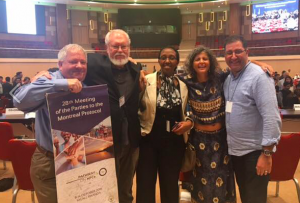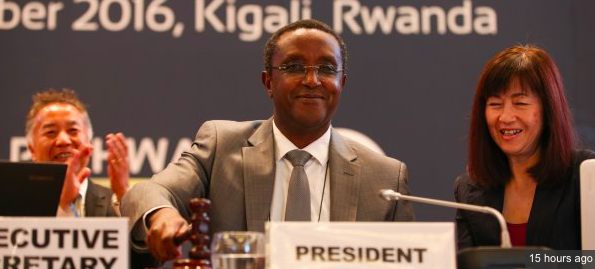Esta entrada también está disponible en: Spanish
October 15, 2016 KIGALI, Rwanda —
Negotiators hugged, kissed and even cried as 170+ global leaders crammed through the night to reach what is effectively the world’s greatest and most ambitious single agreement ever to lower climate temperature. It involves reducing and phasing out contaminants called short-life climate pollutants including chemical compounds called hydrofluorocarbons (or HFCs), found for example, in car, home and office, refrigerant systems. The magnitude of this agreement cannot be underemphasized as this phaseout alone will have the effective result of achieving 25-35% of the needed global climate action to address global warming and most importantly it will achieve this in the short term. John Kerry, the US Secretary of State, in Kigali and one of the most prominent global leaders pushing for the agreement, called it “the biggest thing we can do in one giant swoop.”
Kerry joined colleagues from around the world to lead US negotiations in the gathering held in Kigali Rwanda for the past several days. “The world is looking to us to try to literally save this planet”, said Kerry during the gathering which rapped up this morning with a historic global agreement aimed at reducing global temperatures by at least 0.5 C. Kerry added, “It is likely the single most important step we could take at this moment to limit the warming of our planet and limit the warming for generations to come. ”
“It’s a piece of the pie, … an important piece of the pie, maybe the biggest piece”, said Romina Picolotti, the former Environment Minister of Argentina which has been helping steer global negotiations on this commitment for the past decade. “We’re talking about a political agreement with industry buy-in to reduce 1/2 of a degree C, of the 1.5 to 2 degrees that the Paris Agreement set to achieve in recent negotiations focused on Carbon Dioxide. That’s about 25%-35% of the overall objetive we must reach from our ongoing climate negotiations. This is a fantastic day for our planet and for our climate!”
While the talks at Kigali have gone largely unnoticed in international press, with most attention focused on the evolving UNFCCC process centered on CO2 phaseouts, these negotiations have been ongoing for the past 8 years, and will likely have a much larger impact on halting and reversing climate change than the recent Paris Agreements, focused on CO2 will likely have.
President Obama called the deal “an ambitious and far-reaching solution to this looming crisis.”
HFCs, the focus of what is now being dubbed “The Kigali Agreement”, are particularly troubling for our climate, as they are many times more potent as a climate warmer than CO2 which has been the principal focus of the more well-known and talked-about global climate negotiations that have been extremely difficult and contentious over the years. Another important thing about Short Life Climate Pollutants (which are central to the Kigali Agreement) is that they are an issue that plays out here and now. Unlike CO2, which even if we removed all fossil fuel emissions sources today, would still be in the atmosphere and continue to impact our climate for hundreds and even thousands of years, short life climate pollutant reductions have immediate benefit, in months, weeks, and even days!
The Kigali agreement also takes into count the inequitable distribution of the climate problem, with richer and more developed countries agreeing to take on a bigger share of reductions and importantly, also helping finance phaseouts. Wealthier nations have a greater responsibility to freeze production of HFCs more quickly than poorer ones. Kigali also lays out trade sanctions for violators and sets specific targets and timetables for phaseouts, while the CO2 negotiations with their agreed targets under the Paris Agreement are completely voluntary with only vague commitments by the principal polluters.
The Kigali accord is “much, much, much stronger than Paris,” said Durwood Zaelke, the president of the Institute for Governance and Sustainable Development, a research organization heavily engaged in the lead up to the Kigali Agreement. “This is a mandatory treaty. Governments are obligated to comply.”
Another attractive aspect of the Kigali Agreement is that industry is largely in favor of the transition to more climate-friendly refrigerants. “Our industry is hard at work doing the research on the HFC alternatives,” said Stephen Yurek, the chief executive of the Air-Conditioning, Heating and Refrigeration Institute, an advocacy group. “Getting that right is certainly as important as reaching agreement.”
This historic agreement between 170+ nations adds to a series of recent climate change agreements, including the Paris Agreement which came into force this month. “This will be the trifecta of international climate agreements,” said Andrew Light, a former State Department climate change negotiator. “It’s just extraordinary.”
After an all-night negotiating session, the details emerged early Friday morning, and the agreement was set in stone by gavel at 7 a.m.. The negotiators, some going on two days without sleep, gathered for pictures, hugs and a celebratory breakfast.

For more information:
Romina Picolotti:
[email protected]
+1 415 601-7763

